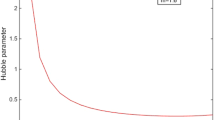Abstract
The Dirac equation is studied for a sufficiently large class of Lemaįtre—Tolman—Bondi cosmological models. While the angular equation (whose solution is known) separates directly, the spatial and temporal dependence de-couples only after a suitable separation procedure. The separated time equation is integrated by series. The separated spatial equation still depends on an arbitrary function relative to the integration of the cosmological model.
Similar content being viewed by others
REFERENCES
Illge, R. (1993). Commun. Math. Phys. 158, 433.
Buchdahl, H. A. (1962). Nuovo Cimento 25, 486.
Wünsch, V. (1978). Beitr. zur Analysis 12, 47.
Wünsch, V. (1979). Beitr. zur Analysis 13, 147.
Penrose, R., and Rindler, W. (1990). Spinors and Space-time(2 vols., Cambridge University Press, Cambridge).
Newmann, E. T., and Penrose, R. (1962). J. Math. Phys. 3, 566.
Birrell, N. D., and Davies, P. C. W. (1982). Quantum Fields in Curved Space-Time(Cambridge University Press, Cambridge).
Chandrasekhar, S. (1976). Proc. Roy. Soc. London A 349, 571.
Chandrasekhar, S. (1983). The Mathematical Theory of Black Holes(Oxford University Press, New York).
Parker, L. (1971). Phys. Rev. D 3, 346.
Unruh, W. G. (1974). Phys. Rev. D 10, 3194.
Ford, L. H. (1976). Phys. Rev. D 14, 3304.
Kalnins, E. G., Miller, W., Jr, and Williams, G. C. (1992). Phil. Trans. Roy. Soc. A 340, 337.
Zecca, A. (1996). J. Math. Phys. 37, 874.
Montaldi, E., Zecca, A. (1998). Int. J. Theor. Phys. 37, 995.
Lemaître, G. (1933). Annales Soc. Sci. de Bruxelles A 53, 51; reprinted (1997). Gen. Rel. Grav. 29, 641.
Tolman, R. C. (1934). Proc. Nat. Academy of Sciences USA 20, 169; reprinted (1997). Gen. Rel. Grav. 29, 931.
Bondi, H. (1947). Mon. Not. Roy. Astron. Soc. 107, 410; reprinted (1999). Gen. Rel. Grav. 31, 1783.
Krasiński, A. (1997). Inhomogeneous Cosmological Models(Cambridge University Press, Cambridge).
Zecca, A. (1993). Int. J. Theor. Phys. 32, 615.
Demiański, H., Lasota, J. P. (1973). Nature Physical Science 241, 53.
Zecca, A. (1995). Int. J. Theor. Phys. 34, 1083.
Teukolski, S. A. (1973). Astrophys. J. 185, 635.
Montaldi, E. and Zecca, A.(1994). Int. J. Theor. Phys. 33, 1053.
Zecca, A. (1998). Nuovo Cimento B 113, 915.
Zecca, A. (1998). Nuovo Cimento B 113, 195.
Author information
Authors and Affiliations
Rights and permissions
About this article
Cite this article
Zecca, A. Dirac Equation in Lemaįtre—Tolman—Bondi Models. General Relativity and Gravitation 32, 1197–1206 (2000). https://doi.org/10.1023/A:1001950718322
Issue Date:
DOI: https://doi.org/10.1023/A:1001950718322




